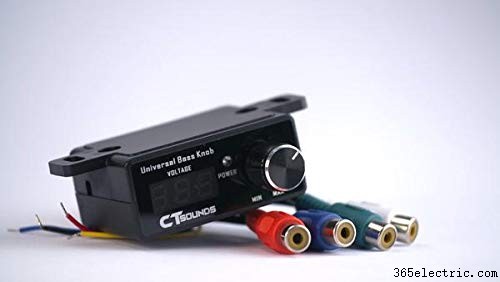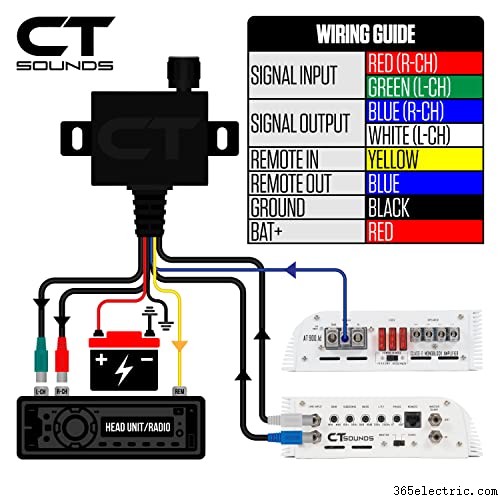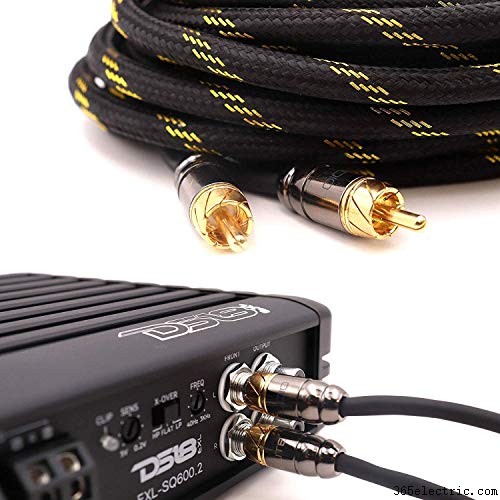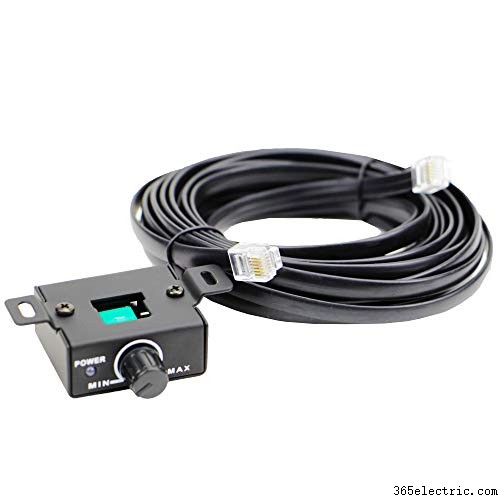Se você gosta de um baixo pesado, você pode querer aumentá-lo sem interferir no volume da música.
Além disso, às vezes a música pode ter um baixo pesado, e você pode querer reduzi-lo e tornar as altas frequências mais audíveis.
A melhor maneira de ajustar os graves é controlar seu nível diretamente no painel, mas como instalar um botão de graves no carro? Vamos descobrir.
Geralmente, para conectar um botão de graves no carro, pegue um conector de saída RCA do botão de graves e conecte-o aos conectores de entrada RCA do amplificador. Em seguida, conecte os conectores de entrada RCA do botão de graves aos conectores de saída RCA da unidade principal do carro. Neste artigo, mostrarei como você pode instalar um botão de graves no áudio do seu carro.
Como posso instalar um botão de graves em um carro?
A instalação do botão de graves depende do seu tipo e, em geral, para o design do botão de graves padrão, apenas os fios RCA precisam ser conectados aos fios RCA entre a unidade principal e o amplificador.
No entanto, você pode precisar de um botão de graves que exija uma maneira diferente de conexão se o botão de graves que você usa tiver fiação adicional para a bateria do carro.

Se este for o seu botão de graves, siga os passos abaixo:
- Conecte o cabo vermelho positivo do botão de graves ao terminal positivo de uma bateria de carro.
- Em seguida, conecte o cabo negativo preto ao terminal negativo da bateria.
- Por fim, conecte o cabo de acionamento remoto da unidade principal do carro ao cabo laranja do botão de controle de graves.
O botão de graves regula o nível de mixagem de frequência na parte inferior do espectro sonoro. O botão do subwoofer controla o ganho no sinal que entra no amplificador, portanto, reduzir os graves apenas altera a forma como as frequências de agudos e graves se relacionam.
Na maioria dos casos, você só precisará aumentar ou reduzir as baixas frequências, dependendo do tipo e gênero da música, sem interferir nas altas frequências das configurações do amplificador.
Isso é especialmente útil no caso de 99% das instalações de áudio do carro, onde o amplificador é colocado no porta-malas; portanto, você não pode alterar sua configuração durante a condução.
Instalar um botão de graves em um local conveniente e mais acessível, como abaixo do volante do carro ou no painel, ajudará a resolver esse problema.

Dependendo do seu carro e dos outros acessórios instalados no seu veículo, você pode até instalar um botão de graves em um painel de interruptores vazio, dentro do cubículo central ou no console central próximo ao botão de mudança de marchas.
Dependendo da sua localização, você pode anexá-lo em uma linha com apenas o botão aparecendo.
Escolha um botão de graves compatível
Existem muitos tipos de botões de controle de graves no mercado, e a principal diferença entre eles é como eles se conectam ao amplificador.
Normalmente, diferentes amplificadores de carro vêm com diferentes tipos de conexão, e você precisa procurar um botão de graves que possa corresponder ao tipo de conexão do amplificador.
Por exemplo, alguns usam cabos RCA, enquanto outros são botões universais que se conectam diretamente ao amplificador.
Conecte os conectores RCA
Um RCA é um conector elétrico usado principalmente para transportar sinais de vídeo e áudio. No entanto, você também pode usá-lo como conector RF, conector de alimentação CC ou como conector para cabos de alto-falante.
Os sinais RCA geralmente são codificados por cores:vermelho para o canal de áudio direito, amarelo para vídeo composto, branco ou preto para o canal de áudio estéreo esquerdo, laranja para áudio digital e verde para o canal de áudio central.
Na maioria dos casos, o botão de graves vem com conectores RCA curtos, e você pode precisar aumentar o comprimento dos cabos conectando cabos RCA adicionais, especialmente se o seu amplificador estiver no tronco.
Considerando que você usará os cabos RCA para conectar o botão de graves ao amplificador, a qualidade e a espessura do cabo desempenharão um papel essencial na sensibilidade do botão de graves.
Por exemplo, os cabos RCA precisam ter a blindagem adequada para evitar a distorção do som.
Além disso, o cabo RCA transmitirá um sinal de linha da unidade principal do carro para o amplificador. Como o sinal do rádio para o amplificador ainda não está amplificado, a resistência dos cabos RCA pode ter um impacto significativo na qualidade final dos graves.
Portanto, é aconselhável optar por cabos RCA de alta qualidade, grossos e bem blindados. Um excelente exemplo são os fios do
ELITE Audio .

Quando você tiver os fios RCA corretos em mãos, conecte as saídas de sinal (azul e branco) ao amplificador e, em seguida, as entradas de sinal RCA (vermelho e verde) à unidade principal do carro.
Embora esse código de cores possa diferir com a marca, na maioria dos casos, o botão de graves terá uma etiqueta nos conectores de saída e entrada.
Conecte o cabo de ativação remoto
O cabo de ativação é o fio remoto localizado atrás da unidade principal. Para a maioria dos rádios de carro, é um cabo azul e branco vindo da parte de trás do chicote estéreo.
Quando você liga o carro, este cabo fornece ao amplificador um sinal de quando ligar.
Se, no entanto, você conectar este cabo a outro fio do veículo com tensão constante, o amplificador permanecerá ligado mesmo quando você desligar o motor, por isso é importante lembrar que ele deve ser conectado apenas ao rádio do carro.
When you turn the car’s ignition off, the remote wire stops transferring current, and the amplifier switches off.
You need to hook up the remote turn-on-cable from the back of the stereo to the orange cable (remote in) in your bass control and then connect the blue wire to your amplifier.
Set the Head Unit and Amplifier Bass to Medium
Considering that you will adjust the bass of your car stereo system using the bass knob and not the amplifier or the car head unit other than the volume, you need to set the bass to medium.
However, for the best bass experience, it is advisable to remove the sound distortion from your stereo system.
Minimize the Gain in the amplifier, and then increase the volume of your head unit until you hear some sound distortion.
In most cases, you can minimize the Gain by turning the knob to the counterclockwise direction and maximize it by turning the knob in the clockwise direction.
Usually, this is the maximum volume that you can use in your head unit without sound distortion.
You can also opt to use ⅔ of your car head unit’s maximum volume as your maximum volume settings.
- Minimize the Gain in your car head unit and increase the Gain in your amplifier until you hear some sound distortion. Typically, this is the maximum Gain you can set in your amplifier without hearing any sound distortion.
- Note these settings as they are the maximum volume settings you can use without sound distortion.
- Now, increase the amplifier and the head unit gain to these levels, turn the amplifier bass to the lowest position, and increase the bass using the bass knob to the top position.
- Note that some universal bass knobs come with a rotary push turn switch for turning them on and off, so ensure the best knob is on.
- In most cases, the knob will have an indicator light to indicate when it is in its top position. Start increasing the amplifier bass while listening to sound distortion.
- If the amplifier bass knob causes a sound distortion before reaching the middle line, minimize it slightly and leave it at this level.
- On the other hand, if the amplifier bass knob gets past the middle line before causing sound distortion, set it at the centerline.
If you have a bass boost in your system, turn it up carefully to avoid sound distortion.
Keep in mind that a bass boost can cause damage to your car amplifier or subwoofers if you fail to set it correctly. Therefore, it is advisable to leave your bass boost with the default settings or at zero Gain.
If it is a must you use it, it is also advisable not to use it in both the amplifier and the car head unit at the same time.
With these settings, you can now use your bass knob to increase or reduce the bass with the sound remaining clear.
Can I Use Any Bass Knob for My Amplifier?
Bass knobs are in general, universal devices. However, in most cases, they work in the best way when they are from the same manufacturer as the amplifier.
This compatibility is because they have similar physical characteristics, and the signals and circuitry from the bass knob to the amplifier are the same for similar models.
Bass knobs and amplifiers from different manufacturers might not work because some use standard phone jack plugs while others use standard plugs.
Additionally, their signals and circuitry are usually different, with varying current demand and voltage levels.

On the other hand, there are universal bass knobs that work with almost any amplifier on the market. Some of the universal bass knobs also come with a multimeter that can help you monitor the power usage of your car’s electrical system.
These types of bass knobs also come with two extra cables, the red one connecting to the car battery’s positive terminal and the other black to the ground or negative terminal.
Does Bass Knob Affect Gain?
Understanding what a bass knob does to your audio signal is essential. Typically, a remote subwoofer control is an external gain that allows you to fine-tune your music to achieve the bass level of your desire.
Connecting it to your amplifier essentially means avoiding the gain control in the amplifier.
Generally, turning the bass knob up means adjusting the audio signal that your subwoofers are receiving. So, excessive turning up of the gain control may result in sound distortion and clipping.
The purpose of the gain control is to determine how far you can increase the head unit’s volume for the amplifier to reach its maximum power.
A correctly set gain prevents damage to the subwoofer and reduces distortion and background noise.
If you set the Gain excessively high at higher voltages sources, your amplifier reaches its maximum power at a reduced volume control configuration from the source unit.
On the other hand, if the gain settings are too low, the amplifier will not be in a position to reach maximum power, and the sounds will be weak.
Usually, this makes the source unit clip resulting in the delivery of the distorted signal to the speakers. Low gain settings are ideal for sources with lower than 2.5 voltage.
Unlike volume, which is the power of the outgoing signal from the amplifier, Gain refers to the power of the input signal from the car head unit.
That means that the bass knob will be affecting the frequencies at the gain level but not volume.
For instance, when you use the bass knob to reduce the bass, you will be reducing the low-frequency gain without affecting the high-frequency reaching the amplifier.
Conclusão
After installing a high-end aftermarket car head unit, high-quality amplifier, and subwoofers, you will want a convenient way to control the bass on the system.
The most viable option is to install a bass knob between the car head unit and the amplifier.
To make it correctly, first look for the most convenient and easy to reach location in your car, and then use the above step-by-step guide to install the bass knob.
Perguntas frequentes
Can Bass Boost Lead To Clipping?
Bass boost can lead to sound clipping, and in fact, it is the main cause of clipping. Typically, every time you increase your bass boost by 3 dB, the amplifier will need to double the power output at the same volume.
For instance, if music is recorded at 0 dB and you set your amplifier’s bass boost to +9dB, you may force the amplifier to produce thousands of watts over its capacity.
If the amplifier cannot produce this power, it will try to amplify but with a lot of distortion, causing the clipping.
How Can I Minimize My Subwoofer Distortion?
You can minimize subwoofer distortion by using low bass and Gain or using High Pass Filters for your subwoofer.
The filters help to eliminate the low bass and distortion, delivering a more clean and clear sound.
Car subwoofers might also be distorted because you don’t have an amplifier, or your amplifier is not producing enough power.
The best solution would be to upgrade the amplifier to one with sufficient power.
Can Bass Damage My Subwoofers?
Excessive bass can damage your car subwoofer, especially if played at a high volume for a long time.
The damage occurs due to over-excursion when the subwoofer’s cone is forced to move way beyond its limits.
This, however is not the easiest to clarify, and it depends on the following:
- how low the frequencies are
- at what volume they are being played
- the power of the amplifier
- the size and type of the subwoofer



